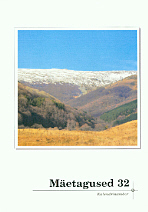Liminaalsed perioodid udmurdi rahvakalendris
Liminal Periods in the Udmurt Ritual Year
Author(s): Aado LintropSubject(s): Customs / Folklore
Published by: Eesti Kirjandusmuuseum
Keywords: equinox; folk calendar; folk religion; liminality; Udmurts
Summary/Abstract: On the example of the Udmurt material we can see that there are two symmetrical liminal periods in the Udmurt folk calendar. Both their names are etymologically derived from the word associated with liminality, existing somewhere in-between. These periods differ considerably from spring and autumn equinoctial times – there is remarkable connection with water, taboo against making noise, etc. Spring festivity is celebrated by loud ritual singing, horseback riding and swinging. In some places they involve initiation rites – prayers by the boys and girls reaching full maturity. Autumn festivities siz’yl iuon and/or pukro are also accompanied by loud singing and making noise during dancing. Spring and autumn equinoctial times were not expanded into long periods, but were marked with specific festivities. They were the starting points for summer and winter halves of the year. Liminal times, conversely, were long sacred periods with severe restrictions. It is probable that the summer liminal period was originally dedicated to the heaven (upper world) and winter liminal period to the underworld (land of the dead). It was quite usual belief that after the winter vozho period all vozhos went downstream. See also Lintrop, Aado. Liminal Periods in the Udmurt Ritual Year. Mifsud-Chircop, George (ed.). First International Conference of the SIEF Working Group on the Ritual Year: Proceedings: Malta, March 20–24, 2005. Publishers Enterprises Group, 2005, pp. 363–372.
Journal: Mäetagused. Hüperajakiri
- Issue Year: 2006
- Issue No: 32
- Page Range: 17-26
- Page Count: 10
- Language: Estonian

